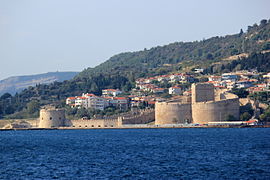Municipality in Çanakkale, Turkey
| Eceabat | |
|---|---|
| Municipality | |
 Kilitbahir Castle built by Mehmed II Fatih in 1452 Kilitbahir Castle built by Mehmed II Fatih in 1452 | |
  | |
| Coordinates: 40°11′02″N 26°21′23″E / 40.18389°N 26.35639°E / 40.18389; 26.35639 | |
| Country | Turkey |
| Province | Çanakkale |
| District | Eceabat |
| Government | |
| • Mayor | Saim Zileli (CHP) |
| Elevation | 0 m (0 ft) |
| Population | 5,636 |
| Time zone | UTC+3 (TRT) |
| Area code | 0286 |
| Website | www |
Eceabat is a small town in Çanakkale Province in the Marmara Region of Turkey, located on the eastern shore of the Gelibolu Peninsula, on the Dardanelles Strait. It is the seat of Eceabat District. Its population is 5,636 (2021). The town lies at sea level. It is an almost entirely modern town.
Eceabat is the departure point for the annual swim across the Hellespont to Çanakkale on the other side of the Dardanelles Strait.
Eceabat is the nearest town to the World War I Gallipoli Campaign battlefield sites, as well as to the cemeteries and memorials to the more than 120,000 Turkish, British, French, Australia and New Zealand soldiers killed during the campaign. This has led to its becoming a major tourism centre, especially around 18 March and 25 April (ANZAC Day) when the two different sides of the struggle commemorate their roles in what happened.
Name
Eceabat's name might have originated from the Arabic military term "hijabat" which means the most forward command point from the battlefield. If so, the meaning might explain the change from the original Madytos.
Attractions
Kilisetepe Mound in Eceabat town covers the site of the original Maydos. The Greek Orthodox church that used to stand on it was demolished in 1923.
Kilitbahir Castle, located 11km south of Eceabat, is an architectural masterpiece, commissioned by Mehmed II in 1462 after the conquest of Istanbul. Süleyman the Magnificent added the Sarı Kule, a tower of large cut stones, to the original fortifications. The castle's heart-shaped layout is unique. The smooth rubble walls were not given great importance but the clover-shaped three courtyards of the inner courtyard were still sheltered. The inner castle has seven floors. Bunkers were added to the site during the Gallipoli campaign. There is a small military museum inside the castle.
Ancient Sestos was on the site of the village of Yalova, Eceabat, 4 km from Eceabat. It was established to the south of Akbaş port. Its stones were reused in the building of Kilitbahir Castle.
Seddülbahir Castle was built in 1659 by Mustafa Ağa, the architect of Frenk Ahmed Pasha, during the reign of Mehmed IV.
Bigali Castle is located 5 km from Eceabat. Work on it began in 1807 during the reign of Selim III; it was completed during the reign of Mahmud II. Stones taken from the lost city of Sestos were used to build the castle.
References
- ^ "Address-based population registration system (ADNKS) results dated 31 December 2021" (XLS) (in Turkish). TÜİK. Retrieved 1 March 2023.
- İlçe Belediyesi, Turkey Civil Administration Departments Inventory. Retrieved 1 March 2023.
- Falling Rain Genomics, Inc. "Geographical information on Eceabat, Turkey". Retrieved 3 March 2023.
- "ECEABAT". www.turkeyfromtheinside.com. Retrieved 3 October 2022.
- "ECEABAT". www.turkeyfromtheinside.com. Retrieved 3 October 2022.
- "KİLİTBAHİR". www.turkeyfromtheinside.com. Retrieved 3 October 2022.
External links
 Media related to Eceabat at Wikimedia Commons
Media related to Eceabat at Wikimedia Commons Eceabat travel guide from Wikivoyage
Eceabat travel guide from Wikivoyage- Road map of Eceabat and environs
- Various images of Eceabat, Çanakkale Archived 30 July 2020 at the Wayback Machine
- Eceabat
| Municipalities | |
|---|---|
| Villages | |
This geographical article about a location in Çanakkale Province, Turkey is a stub. You can help Misplaced Pages by expanding it. |